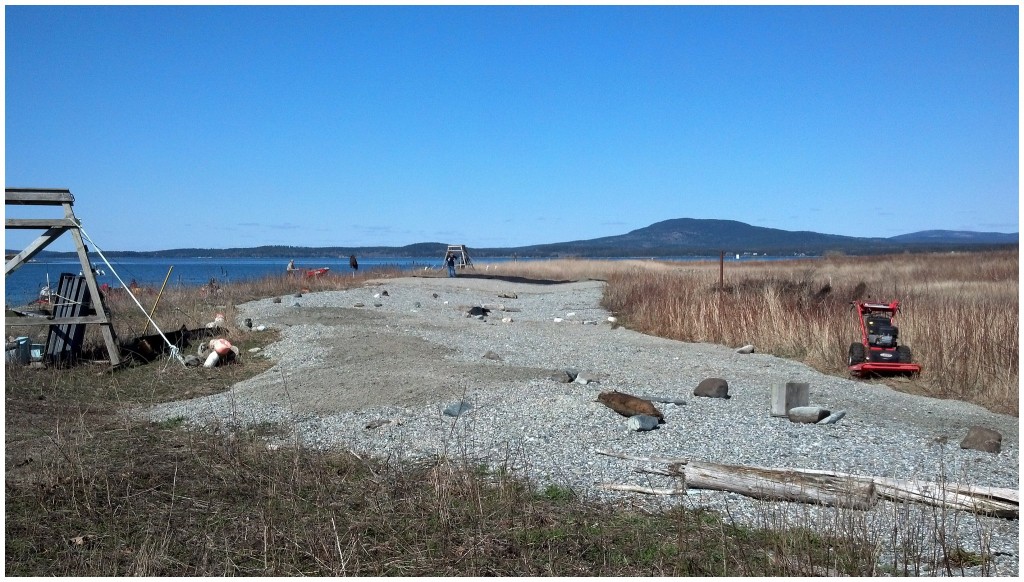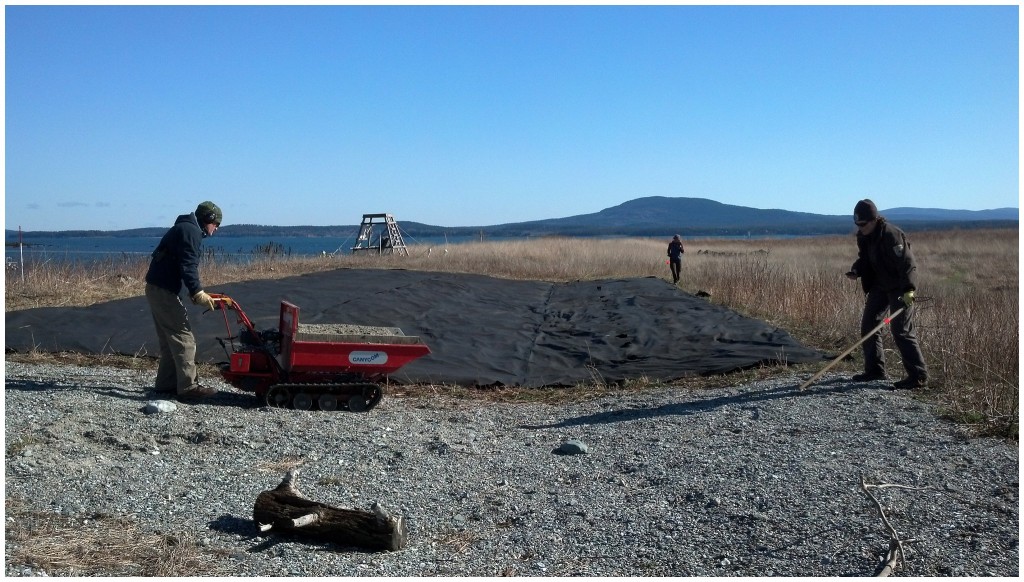May 4, 2016 at 10:08 am
By Sarah Spencer, Region C Wildlife Biologist
In the Downeast Region, biologists frequently work with partners to accomplish tasks aligned with the Department’s mission. A recent example of this collaboration came in mid-April when Region C Wildlife Biologists participated in an effort that was organized by the Maine Coastal Islands National Wildlife Refuge of the U.S. Fish & Wildlife Service to create nesting habitat on a small seabird nesting island in Blue Hill Bay. Additional participants included staff from Acadia National Park, a local wildlife sanctuary, and several volunteers. Common terns, the most numerous seabird species nesting on this particular island, prefer to nest on sand and gravel near one end of the island. Only a strip of this habitat which is approximately 5 feet wide exists between the mean high tide line and tall vegetation. The risk is that an extremely high tide or high tide accompanied by a storm surge can wash over a substantial portion of the nesting area taking nests and even young tern chicks with it. Several years ago a single storm resulted in the loss of 95% of the island’s tern nests.
For this project, USFWS staff transported working partners to the 11.2 acre island by special watercraft that can carry both equipment and personnel. Our goal for the two day effort sounded relatively simple: create more tern nesting habitat protected from wave action. When we arrived, we were shown the 3,000 ft2 of habitat created in 2014 so that we had a good idea of what the result of our efforts would look like. Refuge staff got to work mowing the additional 4,500 ft2 of area in which we would create the habitat. A safety meeting, review of how to use the equipment, and explanation of the process was all we needed before the rest of us got started.
 Once the rank vegetation was mowed, we staked out the boundaries of the project and began unrolling and securing landscape fabric to the ground. We spent the remainder of time on the island shoveling sand and gravel into tracked carts which were then used to transport and dump the material onto the landscape fabric. Others then raked and spread the gravel to grade it to a uniform depth. After two days of hard labor moving about 80 yds3 of material, this island now has 4,500 ft2 of new tern nesting habitat which is secure from flooding. Later this month two seasonal technicians will arrive to apply finishing touches such as driftwood and larger rocks in the nesting area, and will monitor the results of these efforts for 12 weeks.
Once the rank vegetation was mowed, we staked out the boundaries of the project and began unrolling and securing landscape fabric to the ground. We spent the remainder of time on the island shoveling sand and gravel into tracked carts which were then used to transport and dump the material onto the landscape fabric. Others then raked and spread the gravel to grade it to a uniform depth. After two days of hard labor moving about 80 yds3 of material, this island now has 4,500 ft2 of new tern nesting habitat which is secure from flooding. Later this month two seasonal technicians will arrive to apply finishing touches such as driftwood and larger rocks in the nesting area, and will monitor the results of these efforts for 12 weeks.
 All three agencies involved in this project have a common interest in the protection and management of seabird nesting islands and work in partnership to ensure this unique group of birds have adequate nesting habitat. Of approximately 4,000 islands along the coast of Maine, 500 support nesting seabirds and common eiders; yet only 10 of them support 95% of all terns nesting in Maine. Interested in learning more? Go to http://maine.gov/ifw/wildlife/species/birds/seabirds.html for information about seabirds and the habitats they use.
All three agencies involved in this project have a common interest in the protection and management of seabird nesting islands and work in partnership to ensure this unique group of birds have adequate nesting habitat. Of approximately 4,000 islands along the coast of Maine, 500 support nesting seabirds and common eiders; yet only 10 of them support 95% of all terns nesting in Maine. Interested in learning more? Go to http://maine.gov/ifw/wildlife/species/birds/seabirds.html for information about seabirds and the habitats they use.
 Once the rank vegetation was mowed, we staked out the boundaries of the project and began unrolling and securing landscape fabric to the ground. We spent the remainder of time on the island shoveling sand and gravel into tracked carts which were then used to transport and dump the material onto the landscape fabric. Others then raked and spread the gravel to grade it to a uniform depth. After two days of hard labor moving about 80 yds3 of material, this island now has 4,500 ft2 of new tern nesting habitat which is secure from flooding. Later this month two seasonal technicians will arrive to apply finishing touches such as driftwood and larger rocks in the nesting area, and will monitor the results of these efforts for 12 weeks.
Once the rank vegetation was mowed, we staked out the boundaries of the project and began unrolling and securing landscape fabric to the ground. We spent the remainder of time on the island shoveling sand and gravel into tracked carts which were then used to transport and dump the material onto the landscape fabric. Others then raked and spread the gravel to grade it to a uniform depth. After two days of hard labor moving about 80 yds3 of material, this island now has 4,500 ft2 of new tern nesting habitat which is secure from flooding. Later this month two seasonal technicians will arrive to apply finishing touches such as driftwood and larger rocks in the nesting area, and will monitor the results of these efforts for 12 weeks.
 All three agencies involved in this project have a common interest in the protection and management of seabird nesting islands and work in partnership to ensure this unique group of birds have adequate nesting habitat. Of approximately 4,000 islands along the coast of Maine, 500 support nesting seabirds and common eiders; yet only 10 of them support 95% of all terns nesting in Maine. Interested in learning more? Go to http://maine.gov/ifw/wildlife/species/birds/seabirds.html for information about seabirds and the habitats they use.
All three agencies involved in this project have a common interest in the protection and management of seabird nesting islands and work in partnership to ensure this unique group of birds have adequate nesting habitat. Of approximately 4,000 islands along the coast of Maine, 500 support nesting seabirds and common eiders; yet only 10 of them support 95% of all terns nesting in Maine. Interested in learning more? Go to http://maine.gov/ifw/wildlife/species/birds/seabirds.html for information about seabirds and the habitats they use.
Categories